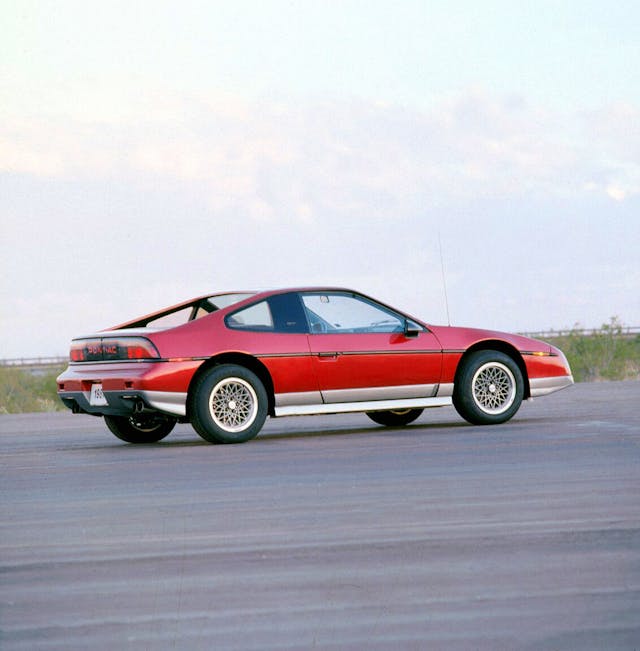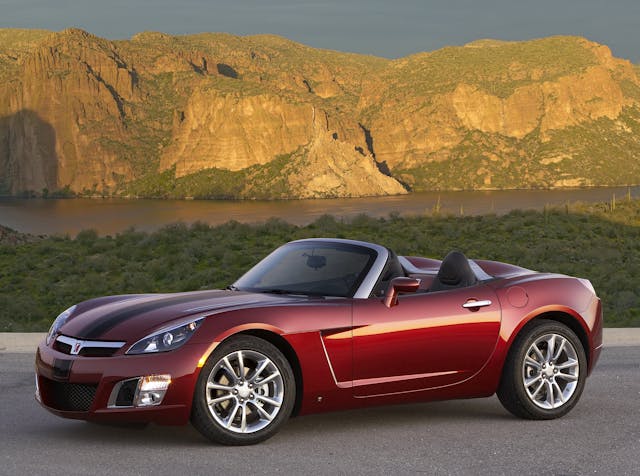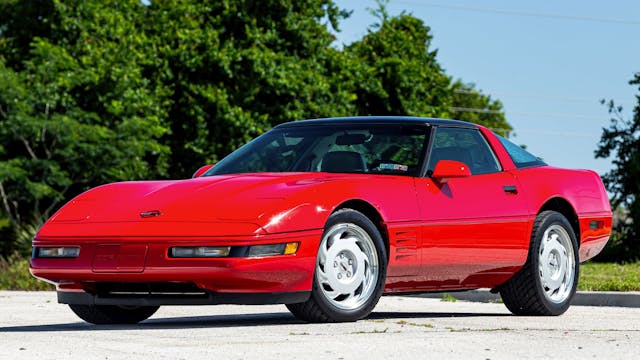Declare Independence From Mediocrity With These Three Underrated American Sports Cars
In the postwar sports car scene in America, European cars were more numerous and more popular. A generation later, Japanese sports cars proliferated yet home-grown choices remained limited. In fact, you could credibly argue that the number of true, two-seater American sports cars can be counted on two hands. Among them, there are three overlooked and somewhat misunderstood but very entertaining choices.
1988 Pontiac Fiero GT

The original Fiero was sold to GM bean counters as an efficient two-seater “commuter” car. Because power and sporty handling weren’t part of the original design brief, the 4-cylinder Iron Duke-powered 1984 Fiero contained a mish-mash of suspension parts from GM underachievers, like the Chevy Chevette and Pontiac Phoenix. It was at least exceedingly thrifty on fuel and actually quite safe despite some engine fires on early cars that tarnished its reputation. But sporty it was not.
Somehow, the Fiero found enough advocates in the vast GM bureaucracy to benefit from some actual development—a decently powerful and growly V-6 and a Getrag 5-speed were quickly added, along with a new flying buttress fastback body style. But the chef’s kiss came with the 1988 Fiero GT, with its revised suspension that was similar to what the engineers wanted in the beginning. While not designed by Lotus (as has been often stated), it certainly bore some of the hallmarks of their designs. Alas, GM killed the Fiero at the exact moment that they got it right, so the Fiero only lived up to its full potential for one year.

Because of its one-year greatness, the 1988 GT is the most valuable of the Fiero family, with a condition #2 (“excellent”) value of $22,000 compared to $17,200 for a 1986 GT. The #3 (“good”) condition value is a rather cheap $12,300. The 1988 Fiero Formula, which has most of the GT equipment but with less flashy styling, is cheaper still with a #2 value of $12,400 and a #3 value of $7700. And this is for a wedgy mid-engine two-seater with a V-6 in a 5-speed. Imagine how much it would be worth if it were European or Japanese.
2007-2009 Saturn Sky Redline Roadster

The Saturn Sky may well be one of the most overlooked sports cars in history. It’s the forgotten twin to the Pontiac Solstice, and many think that it’s the more handsome of the pair. While the 2.4-liter Ecotec-powered base model was somewhat unremarkable, the high-performance model—the Redline—was simply sensational. A new 2.0-liter direct injected and dual-scroll turbocharged engine offered 260hp (up from 177hp in the base car) and 260 lb-ft, while a limited-slip diff further added to the excitement. It was enough to push the Sky Redline to 60 in well under 6 seconds, while the classic rear-drive, front-engine layout and competitive price made it a real alternative to the Japanese and German small sports cars that dominated the segment.
With an excellent chassis, quick and communicative steering, and handsome styling, the Sky Redline should be remembered as one of the best American sports cars of all time. Motor Trend said that “the handling and the drivetrain” make the Sky Redline a true star. Alas, it left a legacy to last a lunchtime, and it seemed to disappear from memory along with the Saturn division itself in the wake of the Great Recession. None of this should stop you from seeking one out. Condition #2 values range from $21,300 to $23,600, and #3 values range from $14,600 to $16,900 depending on model year. The equivalent Pontiac Solstice GXP, which is more distinctive but less elegant than the Saturn, typically runs a few grand less.
1992-1996 Chevrolet Corvette LT1

The C4 (1984-96) generation of Corvette truly gets little respect. It was very nearly a clean-sheet design, and it certainly had the appearance of one, while some truly cool new tech would find its way into the car over its long production run. Although there were some shortcomings on the early cars, maybe the best thing to find its way into the C4 was the LT1 version of Chevy’s evergreen 5.7-liter pushrod V-8, introduced for the 1992 model year. More rev-happy, and pumping out an even 300 hp, it was a 55-hp leap over the L98 that preceded it and it made the complex, expensive and somewhat peaky DOHC ZR-1 feel almost redundant.
Road testers from the big-four mags of the day (Car and Driver, Motor Trend, Automobile, and Road & Track) were unanimous in their praise for the car, deeming it a massive improvement over the previous C4 Corvette. The chassis, which had seen significant improvement over the previous generation C3, remained more than up to the task, especially when working in tandem with Bosch ABS and traction control (the latter could be defeated by flipping a switch).
C4s, even the much better late LT1-powered cars, live in a somewhat uncomfortable middle ground price-wise, in that the subsequent C5 (1997-2004) Corvette is objectively a significantly better car for not much more money while the C3 that came before is a bit antiquated but also has a classic look and charm that the C4 lacks. Regardless, it’s positively criminal how undervalued these late C4s are. Really clean ones sell from the high teens to low-20s depending on year and body style, but a decent LT1-powered driver can be had for under 20 grand easily.
***
Check out the Hagerty Media homepage so you don’t miss a single story, or better yet, bookmark it. To get our best stories delivered right to your inbox, subscribe to our newsletters.



The Saturn Sky was my first choice.
Why make a silly comment that the Solstice is less elegant. Less generic maybe.
So the original Tbird was an an American sports car following the lead of Corvette.
So why was the 2002-05 missed?
I have an 04 mint green one.
290 hp, 0-60; 6.5 seconds, low to the ground, corners well. ITS A 2-SEATER.
23 MPG.
You don’t need a shoe horn to get in and out. And it wasn’t made in Europe like the Alante and Riatta, and I belive the Crossfire. Besides Corvette is there an American sports car ?
I guess silver throw-away Kias and Hyundai s have become the standard in the automotive world.
Main problem with the Sky, Solstice, and C4 Vette convertibles is NO TRUNK. I enjoy my C5 convertible because I can cruise with Mrs. DeSoto and have a couple of overnight bags in case we see a cool hotel or B&B.
Back in the day my daughter wanted to buy a Fiero. It said don’t do it. She did it. She wanted to take the Fiero on a trip to LA, about 500 miles. I said don’t do it. She did it. I got a call from a garage telling me what went wrong with the Fiero and what it would cost to repair it. So, now I have 2 girls stranded in LA because they did what dad said not to do. I paid for the repairs and got the girls home where she sold the Fiero. Daughters, gotta love em.
Another car that has been overlooked is the Chrysler Crossfire. The mechanicals were all Mercedes, and assembled on the same line and platform as the Mercedes SLK 320. The Crossfire’s engine was a 3.2 Liter, V6, with 215 HP @ 5700 RPM, with a top speed of 172 MPH and rear wheel drive with a 6 speed manual Transmission in the roadster, or a 5 speed automatic in the Limited, plus it also has a power convertible top. Whereas the Pontiac Solstice / Saturn Sky has 2.4-liter Ecotec LE5 inline four-cylinder that only produced 177 horsepower, with a top speed of 123 MPH. and a manual convertible top. The specs I quoted are what is published for the base models. Both models have a higher performance version such as the Crossfire SRT6, and the Pontiac Solstice / Saturn Sky has the redline edition.
I wish GM had continued working on the Fiero just as they did with the Corvette. However, they still had a long way to go when they killed it- particularly in the performance department.
Always good to see the C4 Vettes get some love. I have a 96 with 6 speed and the LT4. Always a thrill to drive.
They forgot the Cadillac XLR, a worthy alternative to the Mercedes SL class of its era and a rare hardtop convertible.
I see that many people are overlooking the Dodge Vipers too! They sold for the same price as the corvette’s when new, but they hold the value unlike the vette’s. It is a real interesting automobile. After Chrysler/Lee Iacocca paid off the government loan, then Chrysler continued making those payments towards buying out Maserati, then Lamborghini. From there the Lamborghini V-12 had 2 cylinders cut off and the V-10 was born. Then Carrol Shelby was involved in designing the gen 1 &2 viper bodies. Those vipers were the last “Detroit “ hand built automobiles in the American history. I see more Ferrari’s, Lamborghini’s , Maserati’s etc then Vipers. It a real treat seeing American history
Fantastic car.
I was rolling through the mountains in Southern British Columbia on my souped up HD Road Glide a few years back. Lots of power and lots of suspension mods. In my rear view up pops a Viper riding my rear; I thought I’d let him pass then I’ll tuck in behind and see how I do.
That lasted all of ten seconds and he was gone. I can ride but no way could I hang with that thing!
“Because power and sporty handling weren’t part of the original design brief, the 4-cylinder Iron Duke-powered 1984 Fiero contained a mish-mash of suspension parts from GM underachievers, like the Chevy Chevette and Pontiac Phoenix.”
The REAL story is that the whole idea of the Fiero was to make it out of “a mish-mash of suspension parts from GM underachievers”, but not the rear-wheel-drive Chevette.
It came about because someone noticed that you could take the whole transverse engine/transmission/suspension setup from the -front- of a front-wheel-drive economy car, and put it in the back and make a RWD mid-engine car out of it. Just like an exotic sports car, but dirt-cheap.
Like so many GM ideas (including the Fiero’s generic structure and bolt-on body panels) it was brilliant, but by the time it came through the bureaucratic maze, it was an unfocused, poorly executed mess.
i like the skyy over the solstice in looks, but the rare hatchback is the best to find if you can.
the funny thing is the pontiac and saturn sports cars share a lot of the same things – steering wheels, engines as the MEH, cobalt and the HHR, HHR SS.
i’d be cool with a 93-96 vette with the LT1 – had that in my roadmasters and they were a blast to drive – take off a bunch of weight and even more so – with pretty good mpg too.
I have a 1990 convertible and love driving it, only 69000 on it and it still runs perfect, still have the window sticker, it was 40,000 new
So I read the first article of the day and type out the first comment of the day, take a minute or two to proof read and then submit only to get this:
You are posting comments too quickly. Slow down.
« Back
Happens a lot. Pretty annoying. I had no idea that my posting index figure was so speedy.
I bought my first Fiero GT in February of 86. They came out on January 3rd of 86 so mine was one of the first. Lowend was weak but top end was good. It was rated at a top speed of 125. I know that mine would do at least 135. Speedo was at least an inch past the 125 mark! I now own an 88 GT. Handling wise it is much better than the 86 was. The Fiero was doomed from the start by GM since they didn’t want it to take any sales from the Vette. As far as the values stated in the article I call BS. There are lots of Fieros out there that have less than 100k miles and they sell for anywhere from $3k to $7k every day. There is also a large group of Fiero fans that are very helpful and not pretentious buttholes which is really nice. The only issue that I have with them now is that being north of 60 yrs old they are a pain to get in and out of!